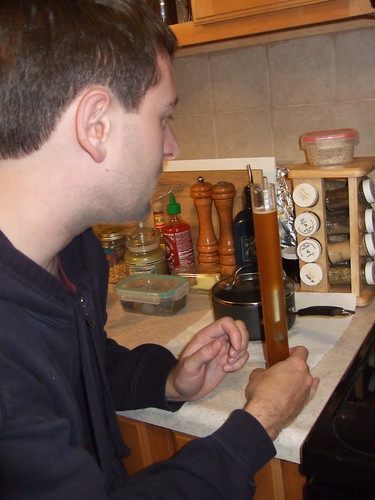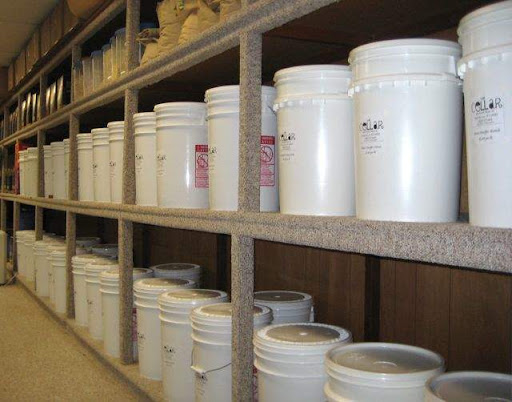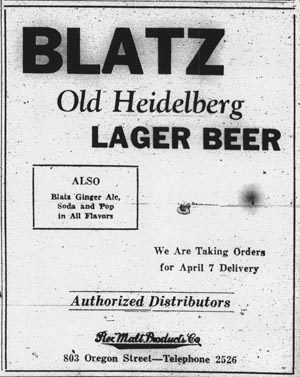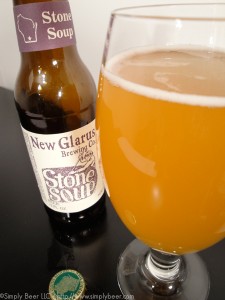 |
| Hydrometer Joe |
Joe Walts has brewed for Otter Creek, J.T. Whitney's and now brews for Fox River Brewing in Oshkosh and Appleton. But it all started with a mess in the kitchen. Here’s Joe telling his own story of how a simple homebrewing kit upended his life.
My poor, poor wife. When we began dating in 1999, I was studying aerospace engineering at the University of Michigan. I played music in my free time, but it was a fairly easy hobby to weave into the fabric of everyday life. After graduating in 2002 and spending the summer goofing around on campus, I accepted a job offer from Williams International - a jet engine manufacturer where I had spent the prior year and a half working as an intern - and my future wife went back to school to become a nurse. We rented a house together and adopted a dog. In three years' time, we'd be able to move someplace cool like Seattle or Hartford (Boeing or Pratt & Whitney). We'd spend a few years as DINKs, taking a nice vacation or two each year, and eventually settle down to raise a family. Aside from being apathetic about my job, life was excellent.
In November of 2002, my stepdad's birthday was approaching. In a last-minute attempt to think of a present, I made a random connection: a friend of mine brewed his own beer when we lived together in college, and my stepdad would love that! My mom would hate it, too. It was perfect. After a meager amount of research, I bought my stepdad a homebrew kit from some shop in California. Thinking "what the hell, that sounds like fun" (I have no idea why it didn't occur to me when my friend was doing it in our kitchen), I bought one for myself as well. I was about to become a fundamentally different person than the guy my future wife had fallen in love with.
I brewed my first batch of beer in March of 2003. It was an amber ale. The kit's instructions didn't include sanitation and, regarding the dry yeast packet, simply said "cool the wort below 95 degf and pitch." When I woke up the next morning, the airlock was plugged and the lid of the 6-gallon bucket had formed a two-inch-high dome. I tried to gently crack the lid to relieve the pressure, but it made a loud “POP” and sent trub all over my kitchen. When I noticed the solids on top of the beer, I concluded the batch was ruined and dumped it down the sink. I didn't give up, though! Not wanting to leave my failure open-ended, I ordered the same ingredients again. While I waited for them to arrive in the mail - I wasn't aware that local homebrew shops existed - I scoured the internet for info and found How to Brew by John Palmer. After reading the first edition, which was (and still is) published for free online, I knew what had gone wrong. Batch #2 was a drinkable success.
By 2004, homebrewing had taken over my life. I was brewing or bottling almost every weekend, I worked on recipes during my lunch hours and the only things I read were brewing-related. I had recently joined the American Homebrewers Association and, after seeing an ad for their National Homebrew Competition in Zymurgy magazine, decided to enter a Chocolate Stout in the New Entrants category. When the regional score sheets arrived in the mail, I was shocked to learn that my beer had qualified for the national finals by taking third place and earning a Gold Certificate. The day of the national awards ceremony, I received a phone call from a guy I'd never met named Jeff Renner. He basically said, "who are you and why don't you belong to our homebrew club? You won bronze and I have your medal." Holy @#$%!! I quickly joined the Ann Arbor Brewers Guild, adding "social life" to my list of things that homebrewing had upended. Amazingly, I got married three months later.
Being a member of a homebrew club was extremely rewarding, and joining the Madison Homebrewers and Tasters Guild was one of the first things I did when I moved to Madison in July of 2005. I was hired as the assistant brewer at J.T. Whitney's at the end of August, but I continued homebrewing (although less often) and remained active in the club. I stayed involved for my own enjoyment, but I'd be lying if I claimed that Whitney's didn't benefit from it. Homebrewers and beer aficionados still set the tone of a brewery's reputation, even if they only account for a small portion of sales, and Whitney's sold about 12% more beer in 2006 than 2005. I'd like to say it was because I improved the beer, but I didn't. As the assistant brewer, I simply followed my boss's procedures that had been in place for ten years. The only difference is that it had been a long time since an MHTG member brewed there. As a consumer, I definitely frequent establishments more often - and spread the word about them - when I know their employees or owners.
My long-term goal as a commercial brewer has always been to have creative and procedural control over what I brew (that goal has evolved over the last few months, but we'll run with it for now). Because I haven't accomplished it yet, brewing at home is still the only way for me to do things my way. Even if I was in charge of a brewery, I'd probably still homebrew from time to time to test new ideas or escape from the constraints of commercial viability. When you're hooked, you're hooked.

Speaking of beer that isn't commercially viable, I brewed a strong raspberry ale in 2006 to celebrate our wedding anniversaries. My wife and I share a champagne bottle of it every year, and it keeps getting better. If I were to brew it again, here's what I'd do:
Serving Volume = 4.5 gal
Original Gravity = 1.120
Bitterness = 40 IBU
Final Gravity = 1.022 (80% apparent attenuation, 11.6% estimated abv)
Carbonation = 2.8 volumes
Water treatment for Oshkosh municipal water:
9.4 gal cold tap water
7 g calcium sulfate
12 g calcium chloride
3 g slaked lime (sold as pickling lime in grocery stores)
1/2 crushed campden tablet or the equivalent weight of potassium
metabisulfite or sodium metabisulfite
Mash Fermentables:
20 lb, 2 oz Pilsner malt
3 lb, 1 oz malted wheat
Adjuncts:
42 oz corn sugar
58 oz raspberries
Hops:
54 g Magnum pellets (13% AA) for 90 min
Yeast:
Wyeast Trappist High Gravity or White Labs Abbey Ale
Lalvin EC-118 (Champagne), if necessary
- Two days before brewing: make a well-aerated yeast starter with 2821 mL of water, 337 g of dried light malt extract and 2 packets of Wyeast Trappist High Gravity or White Labs Abbey Ale yeast.
- The evening before brewing, treat water and allow to sit overnight.
- Before using, decant treated water from sediment.
- Mash grain with 7 gallons (measured cold) of treated water at 162 degf. The target mash temperature is 149 degf.
- During the lauter, the add corn sugar to the kettle and mix well.
- Sparge with the remaining treated water and collect 6.7 gal of wort at a specific gravity of 1.100.
- Add Magnum hops at the start of the boil.
- Boil for 90 minutes. Post-boil wort should be 4.8 gal at a specific gravity of 1.143 (the yeast starter and raspberries are included in the 1.120 original gravity).
- Cool to 68 degf, pitch yeast starter and aerate/oxygenate the hell out of it.
- Try to maintain a fermentation temperature of 72 degf (62-64 degf ambient during high krausen).
- After two weeks: add smashed raspberries to a secondary fermenter and rack the beer onto them*. If attenuation is poor, add a hydrated packet of Champagne yeast.
- After another two weeks, cool beer to 58 degf.
- After another six weeks, bottle or keg the beer. If bottling in champagne bottles: warm to room temperature beforehand, add a hydrated packet of Champagne yeast, prime with 157 g of corn sugar dissolved in 500 mL of water (use 164 g of sugar if raspberries were pasteurized) and let the beer carbonate for months.
*Depending on the source of your raspberries, you may want to pasteurize them. To do so, add 750 mL of water to the smashed raspberries and heat to 150 degf for 30 minutes. Pectin formation shouldn't be a concern at 150 degf, but adding this pasteurization step will reduce the beer's target OG to 1.116.
By the way, my stepdad still hasn't opened his homebrew kit.































